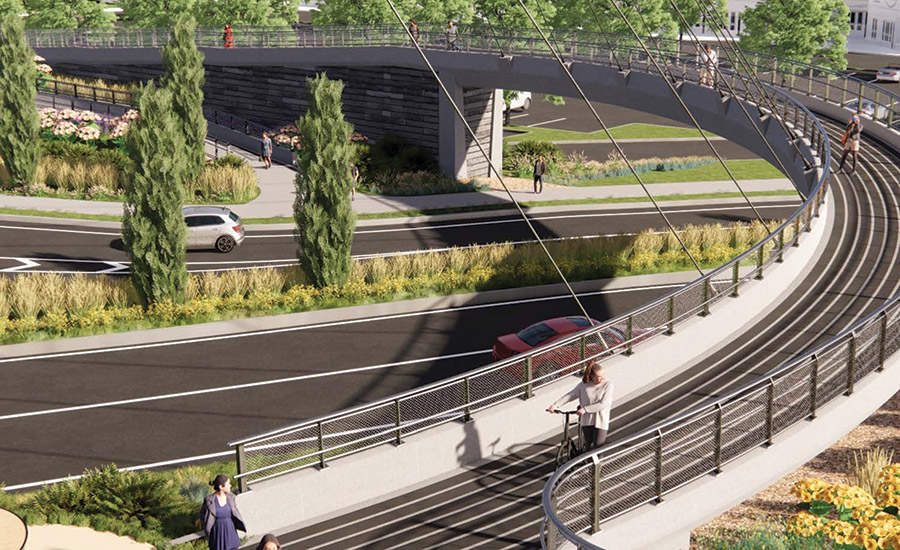On June 11, 2023, less than six weeks after he was sworn in as Pennsylvania Secretary of Transportation, Mike Carroll found himself leading an emergency response with national implications—the collapse of a bridge on I-95 in Philadelphia that was destroyed by fire following a truck crash. The accident cut off a route that carried 160,000 vehicles daily. Working quickly and decisively, Carroll’s PennDOT team joined with its engineering and construction partners to deliver an extremely fast-track solution in just 12 days. The incident illustrated the capabilities of an agency that has faced decades of challenges to keep its vast network of roads and bridges maintained. Since the start of Gov. Josh Shapiro’s administration in January 2023, PennDOT has been positioning itself to respond better to the state’s considerable needs with the help of additional funding and other resources. In light of the agency’s recent efforts, ENR MidAtlantic has named PennDOT its 2024 Owner of the Year. “[The I-95 collapse] was about the highest-profile challenge you could come up with in terms of PennDOT’s network,” Carroll says. “I had confidence that PennDOT and our team could do a lot of really capable things. They were put to the test on I-95.”

A tractor trailer filled with gasoline lost control on June 11, 2023, and flipped on its side, setting an I-95 bridge afire and killing the driver.
Photo courtesy of Philadelphia Fire Dept. Twitter
Soon after that accident, PennDOT’s teams were challenged again to respond quickly when single-span bridges in Bucks County and Lackawanna County needed to be replaced. Each of those bridges opened in about two weeks.
“The numbers are stark, the challenges are real and the legislative solutions are not easy to get.”
— Mike Carroll, Secretary of Transportation, PennDOT
The agency’s need to mobilize when assets fail underscores the significant challenges that PennDOT faces. Pennsylvania has the third-highest number of state-maintained bridges and the fifth-largest number of state-maintained roadway miles in the country. Addressing the critical needs of the state’s bridges—more than 25,000 in total—has been particularly daunting. More than a decade ago, Pennsylvania had more than 6,000 structurally deficient bridges—the most in the U.S. Today, that tally is roughly 2,200—nearly one-third of that previous high-water mark.
Improving the state’s bridge network has required considerable resources. Annually, PennDOT dedicates about 35% to 40% of its letting program for roadways and bridges—which totaled $2.8 billion last year—to bridges alone.
Despite those improvements, Carroll recognizes that the state continues to face an uphill battle, especially when it comes to transportation funding. Before his nomination to become secretary of transportation, Carroll served 16 years in the Pennsylvania House of Representatives, where he saw the challenges firsthand. Before serving in the House, he was a liaison for transportation issues for Gov. Bob Casey Sr. “The challenges of legislating here are real,” Carroll recalls, noting that during his tenure in the House, only two substantive transportation bills were passed. “The numbers are stark, the challenges are real and the legislative solutions are not easy to get.”
The state’s gas tax is among the highest in the nation, but Carroll points out that not all of the revenue is dedicated to transportation–$0.08 per gallon goes to fund the state police. “When you siphon off [funds from the gas tax], all of a sudden we’re middle of the pack in terms of gas tax among the 50 states,” he says.

The I-95 project team built a temporary road with wire walls and glass aggregate fill.
Photo courtesy of PennDOT
Carroll says Gov. Shapiro, a Democrat, worked with him and PennDOT to remedy that, “decoupling the $500 million that we were siphoning off for funding for the Pennsylvania State Police.” Working in increments of $125 million each year for four years, those dedicated funds will no longer be drawn from the gas tax, but instead come from the state’s general fund. Ultimately, that should provide roughly $500 million in additional funding for projects.
Like all states, Pennsylvania was thrown a lifeline by the federal government with passage of the Infrastructure Investment and Jobs Act of 2021. That law will provide the state with an additional $4 billion to use on roadway and bridge projects over five years, beginning in 2023. The state is also applying for discretionary funding, such as grants, that are available through the IIJA. While only a portion of funding has been put to use, what PennDOT has leveraged so far is paying off. In 2023, 684 state and locally owned bridges were put out for bid to be repaired, replaced or preserved. Moreover, 453 construction contracts for highway, bridge and other improvement projects were completed statewide. Meanwhile, PennDOT improved 7,011 roadway miles, including 2,522 miles of paving, surpassing the 2022 total of 6,414. PennDOT estimates that this year 1,762 projects are underway or expected to start or go out for bid this year, with a total value of $11.9 billion.

Crews perform rock cut excavation for the Pennsylvania Dept. of Transportation's Southern Section of the Central Susquehanna Valley Transportation Project.
photos courtesy of PennDOT
Although the additional funding could offer PennDOT the opportunity to pursue major capacity projects, the state plans to stay the course and continue to “peck away” at its critical needs, says Mike Rebert, PennDOT deputy secretary of highway administration. “At this point we’re probably in the best spot we’ve been in in decades,” he says. “A little over 2,200 of our bridges are structurally deficient, which is still a significant number but is under 10%. A large number of those bridges are on our lower-level networks. We’ve really focused on our higher-level networks where we have high volumes of traffic that really drive the economy.”
Rebert hopes the tally of structurally deficient bridges drops below 2,000 within four years. He says even as structurally deficient bridges are improved, more aging bridges may be designated deficient. “It’s a never ending balancing act of replacing bridges versus doing preservation on bridges to make sure that we’re able to keep ourselves in a good spot,” he says. “There are always bridges that are falling into the fair category and will become poor if we don't do something about it. We balance replacing some of our poor bridges with also putting dollars into our fair bridges to either make those fair bridges into good bridges or keep them at a better level than fair.”
Major PennDOT Projects
I-95 Central Access Philadelphia Project
Construction activities began last year on the five-year, $328.9-million replacement and expansion of the existing covered section of I-95 at Penn's Landing along the riverfront in center city Philadelphia. Current construction activities, led by contractor Buckley and Co., include the demolition of bridge structures. In addition to replacing the cap over I-95 between Chestnut and Walnut streets, the project aims to improve pedestrian and multimodal connections between center city and the waterfront. Two main components are a new 11.5-acre park at Penn’s Landing and a new signature bridge at South Street. Both will extend over Columbus Boulevard to connect cyclists and pedestrians to the recently completed Delaware River Trail.
Bayfront Parkway Central Corridor Improvement Construction Project
The $111.7-million Bayfront Parkway Central Corridor Improvement Construction Project in Erie will improve traffic flow and make the waterfront more accessible from downtown, allowing the city to take advantage of one of its key assets for tourism and economic development. The project will upgrade the pedestrian and bicycle amenities along the roadway between Sassafras Street Extension, State Street and Holland Street. It will also address motorized traffic and utility needs as well as create an iconic connection through the construction of a cable-stayed pedestrian bridge at the Holland Street intersection.
Central Susquehanna Valley Project
Construction activities began in 2023 on the $360-million southern section of the CSVT north of Harrisburg. The southern section will include roughly six miles of new four-lane, limited access highway in Snyder County. The northern section was completed in 2022. A year after opening, data showed that CSVT River Bridge carries roughly 16,000 vehicles per day, including 3,800 trucks.
In recent years, the state has also leaned on alternative specifications and delivery methods to help it meet its goals, including accelerated bridge techniques to deliver bridges in a fraction of the time of standard bridge construction. PennDOT is working with industry and legislators on enabling the use of design-build, best-value delivery on major projects.
“At this point we’re probably in the best spot we’ve been in in decades.”
— Mike Rebert, Deputy Secretary, PennDOT
For example, Rebert says that delivery method would work well on a planned bridge on I-83 over the Susquehanna River in Harrisburg. “The cost estimate of that project is over a billion dollars,” he says. “In order to be as efficient as possible, we’re looking at design-build best value. We would design it to, say, a 60% level, and at that point we will get a conceptual design together, we’ll get environmental permits in place and we’ll get right-of-way secured. Then we put that plan out there, and engineers and contractors team together to be as innovative as possible to come up with schemes that we can deliver projects quicker and cheaper.”
In another innovation, PennDOT is piloting digital delivery of projects, requiring the use of 3D modeling. The agency aims to feed that data into an asset management system to better monitor projects statewide.
After a strong 2023 and early indications of an active 2024, some contractors like what they see in PennDOT’s future. The agency is in solid hands with Carroll’s team, says Rob Buckley, president of Buckley & Co., which worked on the I-95 bridge collapse project. “[He’s] probably one of the best people I’ve ever worked with, and I’ve been at this for 49 years,” he says. “He’s not just interested in a photo op, he wants to get things done. When tough decisions had to be made [as on I-95], he listened, he weighed the pros and cons and he trusted his team and his contractors to get it done.”





Post a comment to this article
Report Abusive Comment